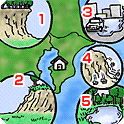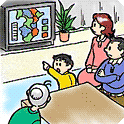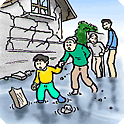Preparation for storm and flood
The Boso Peninsula is surrounded on all four sides by the ocean and rivers, and mountains spread across its southern area; the topology makes it vulnerable to heavy rain and strong winds. Every year typhoons and heavy rain trigger flooding in towns and cities and landslides in the mountainous areas.
Advance Preparation

- Know the land where you live.
- In such places as shown in the illustration, roads may get blocked by water swells or flooding. Make certain that you know which roads are safe to take to reach evacuation places.
- Cliffs with uneven slopes and an overhang
- Cliffs that rise at an angle of more than 30 degrees
- Puddle-prone areas
- Areas where crumbled boulders are scattered
- Areas with a spring nearby
When a typhoon is approaching / heavy rain and strong winds are expected

- Do not leave the house unless necessary.
- Listen to the latest weather reports on the radio and television.
- In areas where there is danger of flooding, move everyday necessities to a safe place.
- Check around the house to make certain that there are no objects that could be blown away by strong winds.
- In areas where there is a danger of landslides, always be prepared for evacuation.
Evacuate as early as possible

- Be sure to evacuate well beforehand, depending on the wind and rain conditions and the physical strengths of yourself and others who will be evacuating with you.
- The sick and the handicapped should take refuge with family members and neighbors.
Evacuation during a flood
- Walking barefoot or in loose boots can be hazardous when evacuating. Wear laced sneakers.
- Since there is no telling what dangers may lurk beneath the surface of the water, use a long stick or pole to check for safety in the water as you walk.
- If the water level exceeds your waist, do not insist upon evacuating but wait in a high place for rescue.


